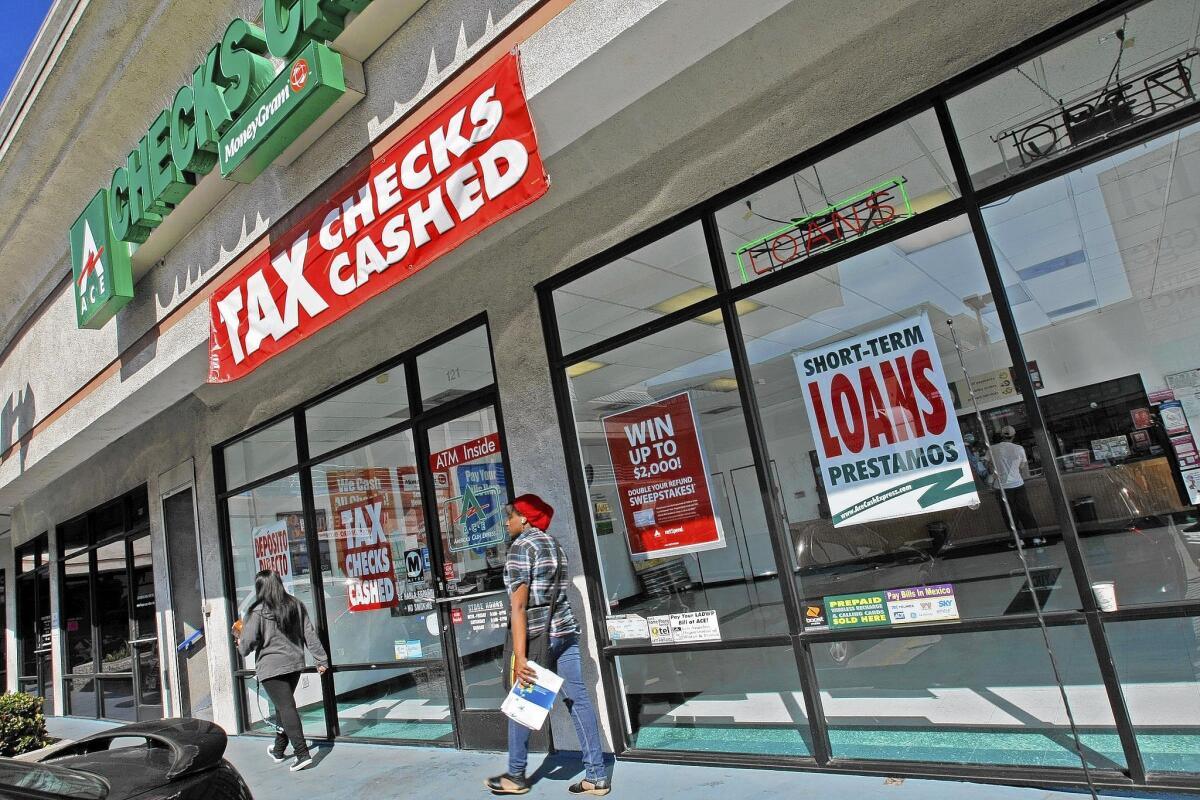Most payday loan borrowers get stuck in ‘revolving door of debt’

- Share via
WASHINGTON — Four out of five people who take out a short-term payday loan either roll it over or take out another one within two weeks, pushing them into a cycle of debt, according to a report to be released Tuesday by the Consumer Financial Protection Bureau.
Nearly a quarter of borrowers — 22% — renewed the loan at least six times, causing them to end up paying more in fees than they originally borrowed, the bureau said in an analysis of 12 million loans made by storefront payday loan companies.
“We are concerned that too many borrowers slide into the debt traps that payday loans can become,” said Richard Cordray, the bureau’s director. “As we work to bring needed reforms to the payday market, we want to ensure consumers have access to small-dollar loans that help them get ahead, not push them farther behind.”
The bureau, created by the Dodd-Frank financial reform law, has been overseeing payday lenders since 2012, the first such federal oversight.
The loans are cash advances on a paycheck, typically for two weeks with a flat 15% fee or an interest rate that doesn’t sound too high. But the costs can quickly multiply if the loan is not paid off or if the borrower needs to take out another to pay off the first one.
Payday loans have been a fixture in working-class neighborhoods, and their use expanded during the Great Recession and its aftermath.
Some banks and credit unions also offer the loans, which they often call deposit advances. But some large institutions, such as Wells Fargo & Co. and U.S. Bancorp, stopped offering them this year after federal banking regulators said they would examine the products to make sure they were affordable for the borrower.
Payday lenders have said some consumers need access to short-term credit and value the loans as long as the terms are clear.
In December, the Community Financial Services Assn. of America, a trade group representing storefront lenders, touted a nationwide poll it commissioned by Harris Interactive that found that 91% of borrowers were satisfied with their payday loan experience.
But public interest groups have argued that payday loans take advantage of vulnerable borrowers, and the consumer bureau has made regulating storefront lenders a priority.
“For consumers in a pinch, getting the cash they need can seem worth it at any cost,” Cordray said in remarks prepared for a Tuesday hearing on payday loans in Nashville, Tenn.
“Many consumers would never dream of paying an annual percentage rate of 400% on a credit card or any other type of loan, but they might do it for a payday loan where it feels like they can get in and out of the loan very quickly,” he said.
The bureau’s report said it can be difficult for borrowers to pay off such loans, causing their costs to skyrocket.
Only 15% of borrowers are able to pay off the loan within 14 days without rolling it over or taking out another, the bureau said.
California and eight other states prohibit payday lenders from rolling over a loan, but allow them to make another loan to the same borrower the day the first one is repaid. Four states impose a waiting period of at least a day. The bureau considers a new loan taken out to pay off an old one to be, in effect, a renewal and part of the same “loan sequence.”
About 48% of initial payday loans are paid off with no more than one renewal or additional loan.
But 1 in 5 borrowers default on a payday loan at some point. And more than 80% of people who renewed or took out new loans ended up borrowing at least the same amount with each successive loan, pushing them into what Cordray called a “revolving door of debt.”
Almost half of payday loans are made to people as part of sequences of 10 or more loans. Given that figure, Cordray said, “one could readily conclude that the business model of the payday industry depends on people becoming stuck in these loans for the long term.”
More to Read
Inside the business of entertainment
The Wide Shot brings you news, analysis and insights on everything from streaming wars to production — and what it all means for the future.
You may occasionally receive promotional content from the Los Angeles Times.










